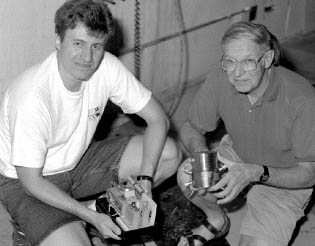 |
|
The Not-So-Good Earth
Minute ground vibrations need to be factored into the design of future colliders. by Sharon Butler
Even on the most ordinary of days, the ground we walk on is, as Vladmimir Shiltsev likes to say, "a sea of micron- and submicron-sized storms, tides, whirls and waves." Shiltsev, a Wilson Fellow at Fermilab, worried that this jiggling of the earth, while imperceptible to the ordinary passerby, might still be enough to perturb the large colliders the Laboratory contemplates building here one day. For Fermilab's Tevatron, ground motion poses no problem. But these future colliders—whether a muon collider, a very large hadron collider or a linear collider—will be very sensitive both because they will be larger than the Tevatron (as large as 500 kilometers in circumference for one design of a very large hadron collider) and because the diameters of their beams will be narrower. Colliding two beams in these machines will thus be tricky. "Imagine two hunters standing dozens or even hundreds of miles apart and shooting tiny bullets only a few dozen microns in diameter to meet halfway and exactly head-on," Shiltsev said. "And the hunters themselves are standing in boats soaring and dipping on turbulent seas." To work, the beams in the accelerators will have to be very stable and precisely positioned. If the beams bump around too much, the "golden orbit"will fizzle. For some accelerator designs, "too much" is a mere 0.3 nanometers of vibration (a mere three-tenths of a billionth of a meter). Accordingly, Shiltsev, along with Fermilab physicist and amateur geologist Joe Lach and physicists from the Budker Institute of Nuclear Physics in Novosibirsk, Russia, set out to test whether the ground in Batavia is too turbulent a sea for future adventures in the high-energy frontier. The physicists measured the earth's motion at frequencies from 0.01 to a few hundred Hertz—whether from natural or "unnatural" causes—both on the surface and in the accelerator tunnel, as well as deep in a nearby mine (since at least one of the proposed accelerators might be built underground in the dolomite rock layer). About 250 feet below the ground in the Conco Western Stone Quarry in North Aurora, just as one might expect, all was relatively quiet on weekends. In fact, it was so quiet that the researchers' seismic probes picked up the famous "seven-second hum," created, remarkably, by the waves of the Atlantic Ocean beating on the eastern shoreline. The probes also picked up the footsteps, and the minute vibrations they prompted, of a solitary miner walking about on a Sunday evening 100 feet away. Over in a tunnel dug for the Metropolitan Water Reclamation District of Greater Chicago, the physicists observed underground motion at frequencies between one and 100 Hertz coming from rush-hour traffic on Interstate 55, about half a mile away. The probes in the tunnel also picked up rumblings of the earth from an earthquake as far away as Chile. At Fermilab, seismic geophones on the surface of the ground clocked the oscillations caused by the workday schedule—including traffic patterns and even the drop in vibration levels when the Lab retires for its lunch break. Probes at different locations—in the Tevatron tunnel and on the surface—recorded ground wave harmonics of 4.6 Hertz stemming from the operation of Fermilab’s Central Helium Liquefier. What do all these earthly palpitations mean for future accelerators? "If you can see them, they're a problem," said Shiltsev. Only those too minute to detect would not disrupt the delicate beams of subatomic particles in future colliders. Traffic patterns, workday activities, soil conditions, precipitation—all influence the vibrations of the earth. One major source of vibrations, Shiltsev said, is the accelerator itself: e.g., the vacuum systems, the stands the magnets sit on, the water that is pumped through to cool the magnets. If the movement of the earth could somehow affect the entire collider at once, lifting and lowering its components all together, the beams would not suffer. But accelerators are strings of magnets and radiofrequency cavities, like sausage links, and vibrations affect different links differently. "If one part of the accelerator is moving up and another part is moving down, and especially if the different elements move abruptly, then we are in trouble,"Shiltsev said. Problems are worse for accelerators built near the surface, which, as the studies showed, is noisier than deeper dolomite layers. In fact, the level of movement that the researchers measured in the Tevatron tunnel, just 20 feet below the surface, is clearly too much for any of the future colliders. But this doesn't mean, Lach explained, that next-generation colliders at Fermilab are all but ruled out. Rather, the researchers have concluded, the sensitive colliders contemplated for the future could happily coexist with the level of ground motion found in the underground mines. The task confronting designers of future accelerators is to understand the levels and sources of vibrations, minimize oscillations due to the accelerator's own components and build "corrector" systems to compensate for the not-so-good earth.
"You'd better know what you're dealing with before you start building," Lach said. And that's why the studies continue.
|
| last modified 8/6/1999 email Fermilab |
FRLsDFx9eyfrPXgV
 The terra is not exactly firma, as any geologist knows.
The terra is not exactly firma, as any geologist knows.